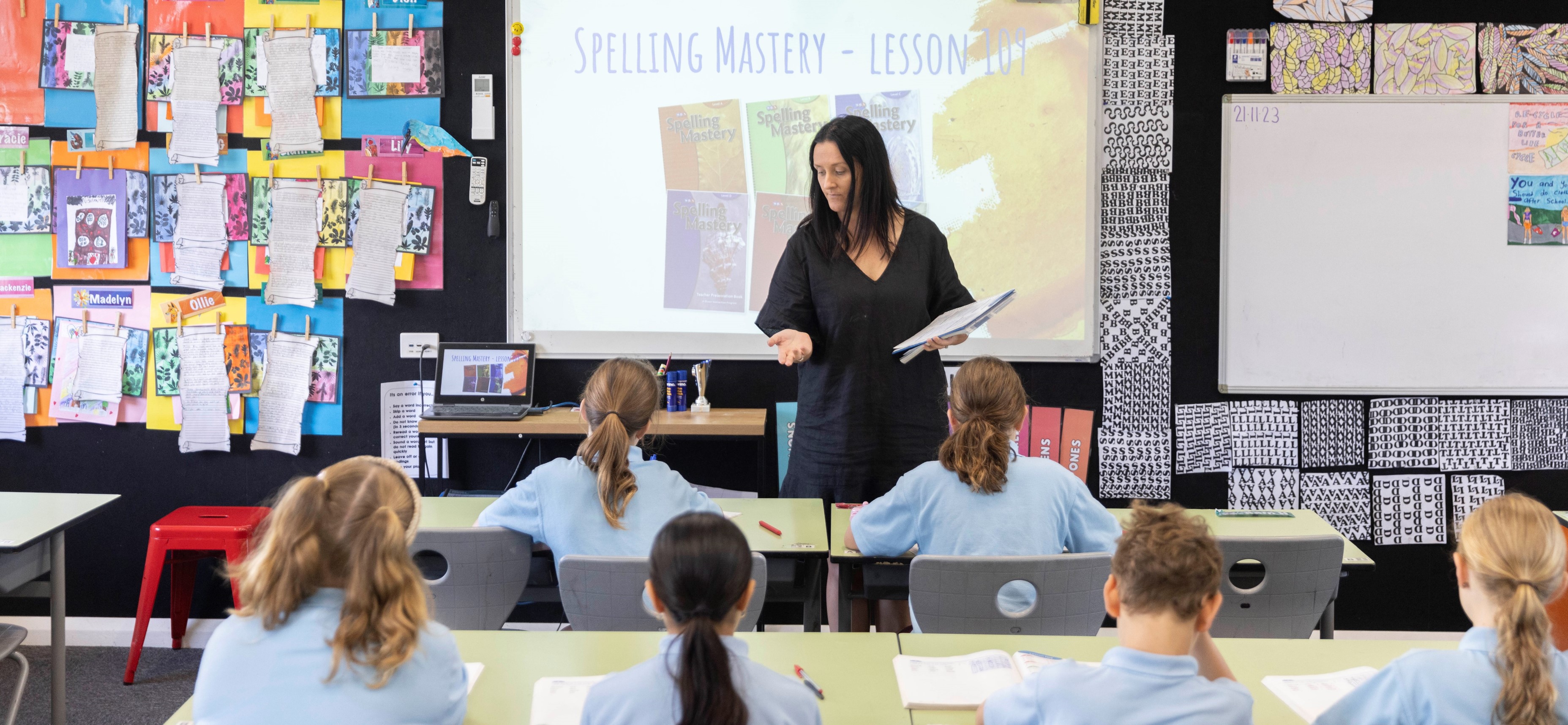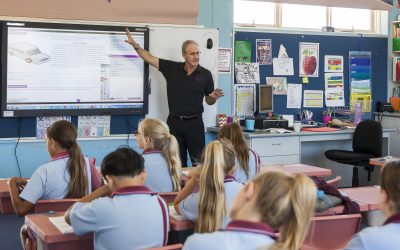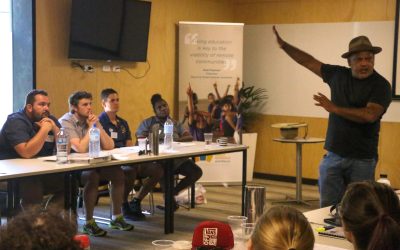This article by Good to Great Schools Australia founder and co-chair Noel Pearson appeared in The Australian newspaper on 12 March 2021.
Rather than letting teachers teach, states and territories are delivering social constructivist pedagogies that leave students behind.
It is now more than 15 years since the National Inquiry into the Teaching of Literacy examined worldwide evidence of the most effective methods for teaching reading. It was headed by the late Professor Ken Rowe, who tragically died in the Marysville bushfire in 2009. Rowe’s panel reported to the then federal education minister Brendan Nelson. It is worth setting out its central recommendation in its entirety:
‘The committee recommends that teachers provide systematic, direct and explicit phonics instruction so that children master the essential alphabetic code-breaking skills required for foundational reading proficiency. Equally, that teachers provide an integrated approach to reading that supports the development of oral language, vocabulary, grammar, reading fluency, comprehension and the literacies of new technologies.’
Since Rowe’s report, the performance of Australian students has continued to decline compared to other school systems around the world. Ours used to be a great system, but we have subsided to merely good, and we are routinely outperformed by many countries that used to be inferior in literacy, numeracy and science.
This decline coincided with unprecedented increased investment in school education. While the investment may not have been equitable, nevertheless we cannot say our declining performance is principally a function of funding.
So what happened after the findings of the Rowe inquiry? Almost nothing.
Why? Because we have not been able to solve the federal problem in school reform. The commonwealth has the cheque book and the states run the public schools. Attempts to drive reforms the commonwealth government may propose flounder because the states (and now territories) just do their own thing.
Nelson and former prime minister John Howard used commonwealth funding to mandate Australian flag poles on school grounds. But they had no hope of mandating phonics teaching in state schools, let alone the other dimensions of the Rowe inquiry’s recommendations.
So Rowe’s report just gathered dust.
Around the same time as the inquiry, I asked Professor Kevin Wheldall from Macquarie University to come to a small school in Cape York to trial the explicit teaching of reading, using his program called Making Up Lost Time in Literacy. This is when I came to understand the reading wars. I was exposed to the visceral ideological war between progressive educators favouring so-called ‘child centred’ education and those favouring ‘teacher directed’ education, of which the teaching of phonics is just one simple but famously contentious element.
Like Rowe, I came to see the evidence favoured teachers actually teaching. Fancy that! That teachers should first teach!
Rowe pulled no punches. He once wrote: ‘Much of what is commonly claimed as ‘effective teaching practice’ … is not grounded in findings from evidence-based research. The prevailing educational philosophy of constructivism (a theory of self-directed learning rather than a theory of teaching) continues to have marked influences on shaping teachers’ interpretations of how they should teach. However, in contrast to teacher-directed methods of teaching, there is strong evidence that exclusive emphasis on constructivist approaches to teaching is not in the best interests of any group of students, and especially those experiencing learning difficulties.’
But my being persuaded by the explicit teaching side of the reading wars was not an ideological matter. Indeed, I had been swept along with their opponents who talked about ‘the new basics’ as opposed to ‘the old basics’. No, it was the performance of the children that convinced me. I could see children learning once their teachers started teaching.
We started using direct instruction in three schools in the Cape in 2010. At the same time, the Queensland education department started supporting another teacher-directed approach championed by John Fleming, a principal of Haileybury College in Melbourne. Explicit Instruction was becoming reputable in various school districts around the state, including in far north Queensland.
Two years ago, the Grattan Institute’s Peter Goss identified that Queensland achieved superior growth rates to other states from about 2010, the reasons for which Grattan was unable to identify.
My view is the answer lies in the state’s adoption of explicit instruction and certain other measures taken after then premier Anna Bligh acted on the advice of Geoff Masters from the Australian Council for Educational Research in 2009. Essentially, Masters followed Rowe’s prescriptions from five years before.
However, this one instance of a school system adopting sensible recommendations and achieving significant gains soon reversed. Explicit instruction has been steadily dismantled and the Queensland system is sliding back to the old normal.
These systems can’t recognise success and have no clue about preserving and enhancing it in their schools. Principals who worked their backsides off leading improvement look with despair as the department replaces them with principals who promptly change course and dismantle their gains. Great schools go backwards to good, and good schools slide backwards to fair.
In 2015, the Abbott government’s education minister Christopher Pyne took up Rowe’s recommendation, 10 years after it was made, and funded the trial of explicit literacy instruction in remote schools in the Northern Territory and Western Australia. The West Australian schools included a group of Catholic schools and state schools.
Three evaluation reports were undertaken for the literacy for remote schools program. A final report was produced in 2019 and was released by now Education Minister Alan Tudge this week.
Evaluators from the University of Melbourne confirm the program was successful in achieving its objectives: to lift literacy of students through explicit instruction in schools, and to develop the teaching skills of teachers.
The organisation I chair, Good to Great Schools Australia, published an article with The Australian Journal of Indigenous Education setting out the growth rates achieved between NAPLAN tests taken by students in Year 3 in 2015 and Year 5 in 2017. And students in Year 3 in 2016 and those same students in 2018.
When you compare the achievement of these student cohorts with other schools around the country at a single point in time, such as the annual NAPLAN results, they are far behind. Because this is where you find kids from remote schools — way behind their mainstream peers.
The question for evaluation is: how far did these students grow over the period of the literacy intervention? This is where the numbers become impressive. When provided with an effective intervention, these students who are often many years behind their grade level start to show growth rates that are above other student cohorts, including mainstream cohorts, especially when schools commit to rigorous implementation and school systems give them strong support. Optimum results occur when time on instruction is protected, teacher turnover is minimised to the best that circumstances allow, school leadership is retained and succession does not involve a new principal coming in and dismantling the program.
In reading, schools involved in the program from 2015 to 2017 averaged 124 per cent growth, while the average growth for comparable ages was 19 per cent and 34 per cent for Australian and very remote Indigenous schools respectively. In grammar and punctuation, schools involved in the program in the same period grew 180 per cent, while growth for Australian schools was 15 per cent, and for very remote Indigenous schools it was 28 per cent.
Kids in these severely disadvantaged schools are way behind the race when they start, and they are not given the means to move forward. In fact, the gap gets larger over the course of their ‘schooling’ years. I say ‘schooling’ because what these kids get does not resemble any kind of decent definition of proper schooling.
But explicit, teacher-led instruction in reading, as well as maths and science, can get them moving forward. But you need school systems to agree on one thing: to follow the findings of the Rowe inquiry on what works with the teaching of literacy.
There is no such agreement in our federation. The states and territories are still predominantly delivering social constructivist pedagogies, to the disadvantage of the nation’s most vulnerable students.
When the Abbott government’s program started in 2015, the Country Liberal Party government embraced it in the Northern Territory and announced in the second year that positive results were showing up in remote schools using direct instruction. Then the government changed, and the new Labor government began to withdraw schools and refused to provide achievement data from their schools as previously agreed by their CLP predecessors. The final evaluation was not provided with the Northern Territory reading data, except for one school. Why?
I have learned that relatively advantaged students, such as those from Catholic schools in Western Australia, end up benefiting from effective literacy approaches whereas students from the most disadvantaged Indigenous schools do not, because the level of ideological resistance to effective teaching in public education is debilitating. The poor therefore suffer and have no way of breaking out of their social and economic disadvantage without effective schooling.
Evaluations are a mixed bag, and this one is no exception. The positive impact on student learning is confirmed, as is the impact on teacher capabilities. However, the academics can’t help themselves, and they betray their academic predisposition towards constructivism rather than teacher-directed learning.
The evaluators devote more time on an obscure academic from Durham University, a Professor Davis whose four-page article they reference is just a diatribe against the very notion of evidence-based teaching. More heed is paid to Davis than to John Hattie’s landmark meta-analyses in his 2009 book Visible Learning, which sets out the large evidence base for direct instruction. Why would evaluators cavil with the well-established international evidence in the context of the evaluation of a small sample like these schools?
More bizarre is their referencing of Yong Zhou, an American academic whose entire thesis is this: direct instruction may improve test scores but there are negative side-effects such as the impact on student creativity and critique. No evidence of these side-effects is given, and anyone familiar with this horse excrement will know that the creativity and critique argument was alleged against direct instruction more than 50 years ago.
The evaluators are effectively saying, yes our job is to evaluate planet earth, but we will also pay heed to the flat earthers. Most troubling, however, is the assumption that what works for children from many diverse cultural, socio-economic and learning disability backgrounds, somehow doesn’t apply to Indigenous learners. This is an insidious fallacy that has no foundation in any evidence that I’ve ever heard about. The starting point to any approach to educational policy must be that Indigenous children have the same cognitive learning mechanisms and capabilities as other human learners. What is effective instruction for Hispanic migrant children in Texas or middle-class students in a Jewish school in Sydney is effective for Indigenous kids. Contexts must be taken into account, but this implication that Indigenous learners are different is a disgracefully wrong assumption perpetuated by these evaluators.
The new federal minister is well aware of this policy history. He and I talked about Rowe and the challenges facing Australian school education ever since he first came from Harvard to work in Cape York 20 years ago. He is now in the driving seat.
Can he make the school education federation work for all of Australia’s children?
Noel Pearson is a director of Cape York Partnership and co-chair of Good to Great Schools Australia.



